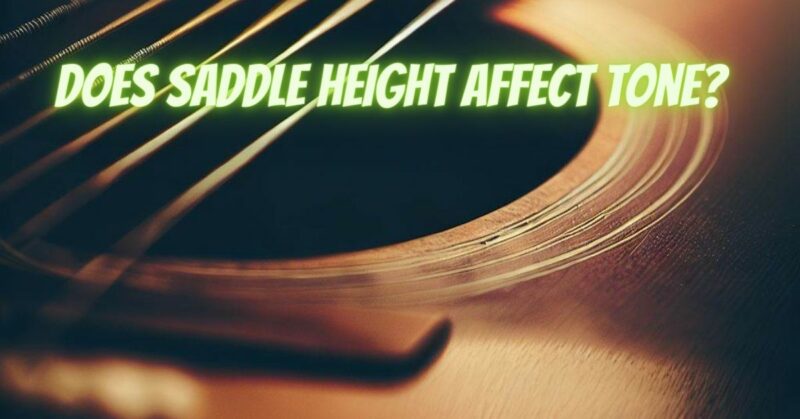When it comes to crafting the perfect guitar tone, every detail matters. One often-overlooked but critical element in achieving your desired sound is the saddle height. The saddle, located on the bridge of your acoustic or electric guitar, plays a pivotal role in shaping your instrument’s tone. In this article, we’ll explore the connection between saddle height and tone, uncovering how this subtle adjustment can significantly impact your guitar’s sonic characteristics.
Understanding the Saddle and Its Role
Before we dive into the effect of saddle height on tone, let’s clarify the concept:
- Saddle: The saddle is a small, often bone or synthetic component situated on the bridge of your guitar. It serves as the point of contact for your guitar’s strings, transmitting their vibrations to the soundboard.
Saddle Height and Its Influence on Tone
The height of the saddle profoundly influences your guitar’s tone in several ways:
- Tonal Brightness vs. Warmth: Adjusting the saddle height can shift your guitar’s tonal balance. A higher saddle typically increases string tension, resulting in a brighter, more pronounced high end. Conversely, a lower saddle reduces tension and can produce a warmer, mellower tone.
- Volume and Projection: Saddle height affects the amount of energy transferred from the strings to the soundboard. A higher saddle can generate more string-to-soundboard contact, increasing volume and projection. Lowering the saddle may produce a quieter, more intimate sound.
- Action and Playability: Saddle height also influences the action, or string height, of your guitar. A higher saddle raises the strings, increasing action and potentially making it more challenging to play. A lower saddle reduces action, making the guitar more comfortable but potentially affecting string buzz and playability.
- String-to-Surface Contact: The saddle’s height impacts the point of contact between the strings and the saddle. A well-balanced saddle height ensures even string-to-surface contact, enhancing sustain and note clarity.
- Harmonic Overtones: Changes in saddle height can affect the harmonic overtones produced by your guitar. Experimenting with saddle height can help you emphasize specific harmonics, adding character and complexity to your tone.
Factors Influencing Saddle Height and Tone
Several factors can influence saddle height and, consequently, your guitar’s tone:
- String Gauge: The thickness of your guitar strings can affect saddle height. Heavier gauge strings exert more tension, potentially requiring a higher saddle to maintain proper action.
- Playing Style: Your playing style, encompassing techniques like fingerpicking, strumming, and flatpicking, can interact with saddle height to produce various tonal nuances.
- Nut Height: The height of the nut at the other end of the string also impacts overall string height and can interact with saddle height adjustments.
- Guitar Setup: A well-set-up guitar with proper saddle and nut heights ensures that your guitar’s tone and playability are optimized.
Experimenting with Saddle Height
If you’re interested in exploring the impact of saddle height on your guitar’s tone, consider the following:
- Consult a Luthier: Seek the expertise of a professional luthier or guitar technician to make saddle height adjustments. They can assess your guitar and make precise alterations to achieve your desired tonal goals.
- String Gauge and Type: Experiment with different string gauges and materials to find the combination that works best with your saddle height adjustments.
- Play and Listen: Spend time playing your guitar and listening carefully to the tonal changes resulting from saddle height adjustments. Pay attention to brightness, warmth, volume, and playability.
- Recording and Comparing: Record your guitar with various saddle heights to compare the tonal differences objectively.
Saddle height is an essential component in shaping your guitar’s tone. Understanding how saddle adjustments affect brightness, warmth, volume, and playability can empower you to fine-tune your instrument to match your musical style and artistic expression. Whether you seek a brighter, more pronounced tone or a mellower, warmer sound, saddle height adjustments offer a versatile tool for achieving your desired guitar tone.


